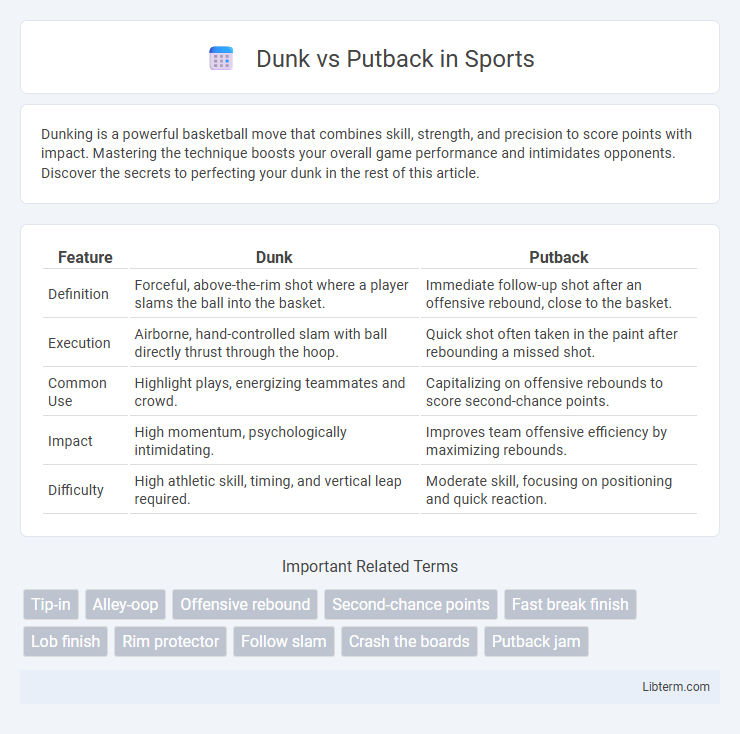Dunking is a powerful basketball move that combines skill, strength, and precision to score points with impact. Mastering the technique boosts your overall game performance and intimidates opponents. Discover the secrets to perfecting your dunk in the rest of this article.
Table of Comparison
| Feature | Dunk | Putback |
|---|---|---|
| Definition | Forceful, above-the-rim shot where a player slams the ball into the basket. | Immediate follow-up shot after an offensive rebound, close to the basket. |
| Execution | Airborne, hand-controlled slam with ball directly thrust through the hoop. | Quick shot often taken in the paint after rebounding a missed shot. |
| Common Use | Highlight plays, energizing teammates and crowd. | Capitalizing on offensive rebounds to score second-chance points. |
| Impact | High momentum, psychologically intimidating. | Improves team offensive efficiency by maximizing rebounds. |
| Difficulty | High athletic skill, timing, and vertical leap required. | Moderate skill, focusing on positioning and quick reaction. |
What is a Dunk?
A dunk is a basketball maneuver where a player forcefully thrusts the ball directly through the hoop with one or both hands, demonstrating power and control. It is one of the most high-energy and crowd-pleasing plays, often executed close to the basket during fast breaks or offensive rebounds. Unlike a putback, which is a quick shot after retrieving a missed field goal, a dunk emphasizes athleticism and dominance in scoring.
What is a Putback?
A putback in basketball occurs when a player immediately scores after retrieving an offensive rebound, often by dunking or laying the ball back up quickly. Unlike a dunk made during an initial possession, a putback capitalizes on a missed shot, emphasizing quick reaction and positioning near the basket. This play is crucial for increasing second-chance points and maintaining offensive momentum.
Key Differences Between Dunk and Putback
Dunk and putback are both high-impact basketball plays that involve scoring near the rim but differ significantly in execution and timing. A dunk occurs when a player forcefully thrusts the ball directly through the hoop, often on a fast break or in set plays, showcasing athleticism and control. In contrast, a putback is a quick rebound and immediate score attempt following a missed shot, emphasizing positioning and anticipation rather than sheer power.
The Mechanics of a Dunk
The mechanics of a dunk involve explosive leg strength, precise timing, and hand-eye coordination to propel the player above the rim, allowing them to slam the ball directly into the basket. Key muscle groups engaged include the quadriceps, calves, and core, which generate the necessary lift and control during the jump. Unlike a putback, where a player rebounds the ball and immediately scores on the second chance, a dunk requires a controlled approach and vertical leap to execute a powerful, high-percentage shot.
The Mechanics of a Putback
A putback occurs when a player immediately grabs an offensive rebound and scores in a single continuous motion, often following a missed shot. The mechanics involve quick vertical leap timing, strong hand-eye coordination to secure the rebound, and explosive body control for a rapid finish near the basket. Proper foot positioning and core strength are essential to maintain balance during the rebound and execute a powerful, controlled dunk or layup.
Dunk vs Putback: Scenarios on the Court
Dunks occur when a player forcefully scores by thrusting the ball directly through the hoop during fast breaks or isolation moves, showcasing athleticism and control. Putbacks happen when a player immediately follows a missed shot with a rebound and quickly scores, often in congested areas near the basket. Dunk scenarios typically involve open space and momentum, whereas putbacks require quick reaction and positioning amid defenders.
Impact on Team Momentum
Dunks generate high-impact visual momentum, instantly energizing both the team and the crowd, often resulting in a psychological boost that can shift game dynamics. Putbacks demonstrate determination and effort on the offensive glass, sustaining possession and creating second-chance points that maintain team momentum during critical stretches. Both plays enhance team confidence but dunks tend to have a more immediate and noticeable effect on the overall energy levels.
Famous Dunks vs Memorable Putbacks
Famous dunks like Michael Jordan's iconic free-throw line dunk and Vince Carter's 2000 Olympics slam captivate fans with their high-flying style and highlight-reel impact. Memorable putbacks, such as Tim Duncan's game-winning tip-ins and Andre Drummond's relentless offensive rebounds, showcase determination and timing, turning missed shots into crucial points. Both plays emphasize different skills: dunks highlight athleticism and flair, while putbacks demonstrate hustle and situational awareness in basketball.
Training Tips for Dunks and Putbacks
Effective training for dunks and putbacks emphasizes explosive leg strength, core stability, and precise timing. Plyometric exercises like box jumps enhance vertical leap, while strength training targeting the quadriceps, hamstrings, and calves improves power. Practicing approach mechanics, such as footwork and hand positioning, refines accuracy and control for both dunks and second-chance putbacks.
Which is More Effective: Dunk or Putback?
Dunks generally have a higher success rate due to their close-range execution and forceful impact, making them one of the most effective scoring methods in basketball. Putbacks, though slightly less reliable, capitalize on offensive rebounds and provide second-chance points that are crucial in fast-paced games. The effectiveness of a dunk versus a putback often depends on player positioning, timing, and defensive pressure within the paint area.
Dunk Infographic

 libterm.com
libterm.com